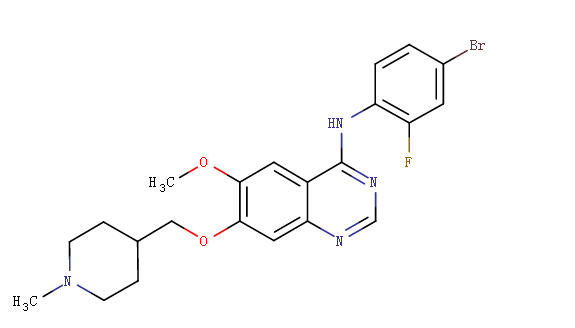Vandetanib
Other name
-
International/Other brands
Caprelsa
Groups
Approved
Structure

Prescription products
| Name | Dosage | Strength | Route | Labeller |
|---|---|---|---|---|
| Caprelsa | Tablet | 100 mg/1 | Oral | Astra Zeneca Lp |
| Caprelsa | Tablet | 300 mg | Oral | Sanofi Genzyme, a Division of Sanofi Aventis Canada Inc |
| Caprelsa | Tablet, film coated | 100 mg | Oral | Genzyme Europe Bv |
| Caprelsa | Tablet | 300 mg/1 | Oral | Genzyme Corporation |
| Caprelsa | Tablet | 100 mg | Oral | Sanofi Genzyme, a Division of Sanofi Aventis Canada Inc |
| Caprelsa | Tablet | 300 mg/1 | Oral | Astra Zeneca Lp |
| Caprelsa | Tablet | 100 mg/1 | Oral | Genzyme Corporation |
| Caprelsa | Tablet, film coated | 300 mg | Oral | Genzyme Europe Bv |
Target
VEGFA
Description
Vandetanib is an oral once-daily kinase inhibitor of tumour angiogenesis and tumour cell proliferation with the potential for use in a broad range of tumour types. On April 6 2011, vandetanib was approved by the FDA to treat nonresectable, locally advanced, or metastatic medullary thyroid cancer in adult patients.
Indications
Vandetanib is currently approved as an alternative to local therapies for both unresectable and disseminated disease. Because Vandetanib can prolong the Q-T interval, it is contraindicated for use in patients with serious cardiac complications such as congenital long QT syndrome and uncompensated heart failure.
Other indications
-
Mechaism of action
-
Absorption
Slow- peak plasma concentrations reached at a median 6 hours. On multiple dosing, Vandetanib accumulates about 8 fold with steady state reached after around 3 months.
Metabolism
Unchanged vandentanib and metabolites vandetanib N-oxide and N-desmethyl vandetanib were detected in plasma, urine and feces. N-desmethyl-vandetanib is primarily produced by CYP3A4, and vandetanib-N-oxide is primarily produced by flavin–containing monooxygenase enzymes FMO1 and FMO3.
Toxicity
-